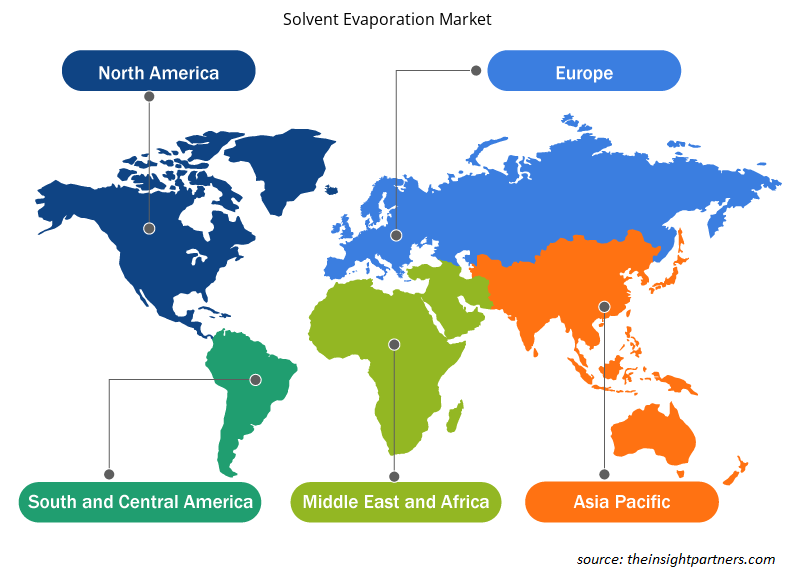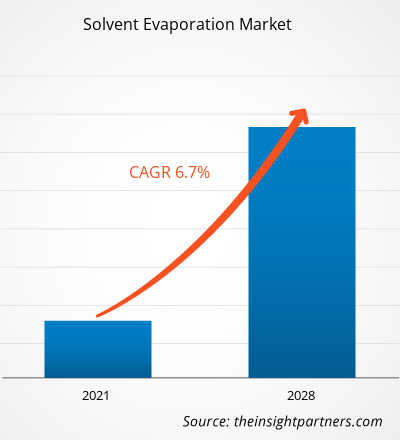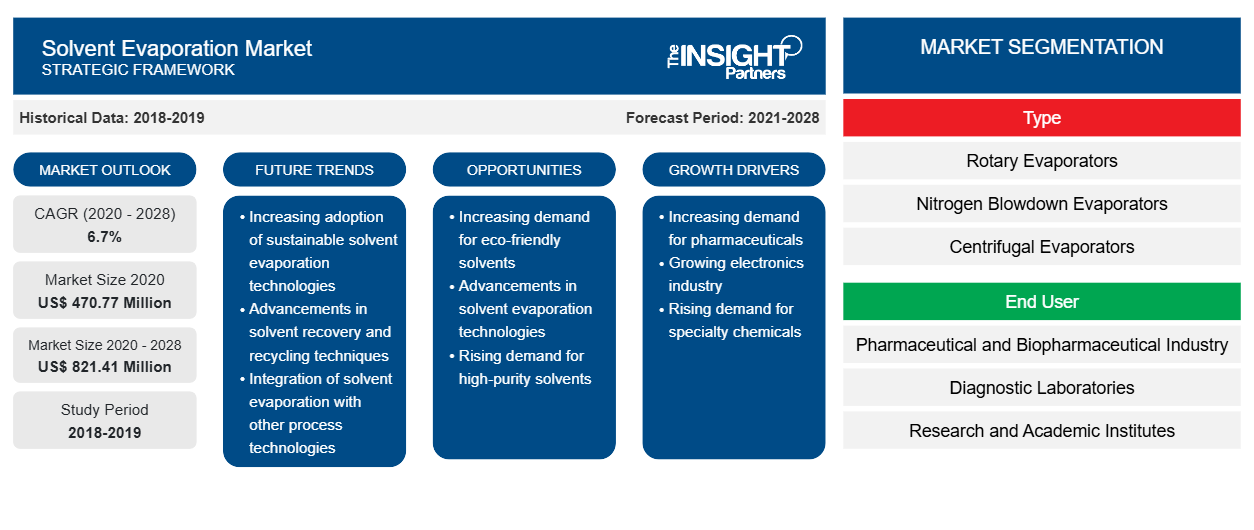Il mercato dell'evaporazione dei solventi è stato valutato a 470,77 milioni di dollari nel 2020 e si prevede che raggiungerà gli 821,41 milioni di dollari entro il 2028; si prevede una crescita a un CAGR del 6,7% nel periodo 2021-2028.CAGR of 6.7% during 2021–2028.
L'evaporazione del solvente comporta l'emulsione del polimero in fase acquosa e la dispersione in un solvente volatile come diclorometano, cloroformio e acetato di etile. Quindi il solvente viene evaporato utilizzando alte temperature, vuoto o agitazione continua. La dimensione delle particelle può essere controllata regolando parametri come la manipolazione della temperatura di evaporazione, il controllo della velocità di evaporazione, la manipolazione della velocità di agitazione, ecc. Questo metodo viene praticato per le nanoparticelle sviluppate utilizzando rispettivi polimeri come PLA, PLGA, PCL, poliidrossibutirrato, ecc. caricati con vari farmaci come tossoide tetanico, testosterone, loperamide, ciclosporina A e indometacina. Gli evaporatori di solvente sono ampiamente utilizzati in processi come la microincapsulazione e sono necessari per preparare nanoparticelle polimeriche per varie formulazioni farmaceutiche. I progressi tecnologici nei sistemi di evaporazione del solvente, come la concentrazione centrifuga, la liofilizzazione e le trappole fredde ad alta potenza, hanno portato a una migliore evaporazione e a un migliore recupero del solvente, con un impatto ambientale minore.
Fattori quali l'aumento della spesa in R&S, il crescente sviluppo di biofarmaci a grandi molecole, la crescente domanda di campioni puri nei mercati di utilizzo finale guidano la crescita del mercato dell'evaporazione del solvente. Tuttavia, le imprecisioni nei risultati e lo spreco di risorse dovuto al disagio associato all'evaporazione del solvente ostacolano la crescita del mercato dell'evaporazione del solvente .biopharmaceuticals, surging demand for pure samples in end-use markets drive the growth of the solvent evaporation market. However, inaccuracies in results and wastage of resources due to uneasiness associated with solvent evaporation hinder the
Personalizza questo report in base alle tue esigenze
Riceverai la personalizzazione gratuita di qualsiasi report, comprese parti di questo report, o analisi a livello nazionale, pacchetto dati Excel, oltre a usufruire di grandi offerte e sconti per start-up e università
-
Scopri le principali tendenze di mercato in questo rapporto.Questo campione GRATUITO includerà analisi di dati che spaziano dalle tendenze di mercato alle stime e alle previsioni.
Approfondimenti di mercato
Aumento della spesa in R&S nel settore farmaceutico
Le sostanze attive dell'evaporazione del solvente sono un passaggio essenziale nel processo di scoperta dei farmaci, in quanto vengono utilizzate in fasi quali sintesi, preparazione del campione e riciclaggio del solvente, nonché nell'aumento della produzione di nuove terapie. Molte aziende farmaceutiche investono enormi quantità nel processo di ricerca e sviluppo (R&S) che ruota principalmente attorno alla scoperta e allo sviluppo di molecole innovative. Secondo un rapporto pubblicato su Statista, la spesa globale per la R&S farmaceutica è stata di circa 181 miliardi di $ nel 2018 e si prevede che raggiungerà i 223 miliardi di $ entro il 2026. Secondo l'India Brand Equity Foundation, le aziende farmaceutiche indiane hanno investito circa il 7,0% dei loro ricavi nel processo di R&S nel 2015 e gli investimenti in R&S sono cresciuti dell'8,6% nel 2019. Pertanto, l'aumento della spesa in R&S sta alimentando la crescita del mercato dell'evaporazione del solvente.Statista, the global spending on pharmaceutical R&D totaled US$ ~181 billion in 2018, and it expected to reach US$ 223 billion by 2026. As per the India Brand Equity Foundation, Indian pharmaceutical companies invested ~7.0% of their revenues in the R&D process in 2015 and R&D investment grew by 8.6% in 2019. Thus, increasing R&D expenditure is fueling the growth of the solvent evaporation market.
Informazioni basate sul tipo
In base al tipo, il mercato dell'evaporazione del solvente è segmentato in evaporatori rotanti, evaporatori a blowdown di azoto, evaporatori centrifughi ed evaporatori a flusso d'aria a spirale. Il segmento degli evaporatori rotanti ha detenuto la quota maggiore del mercato nel 2020. Tuttavia, si stima che il segmento degli evaporatori a blowdown di azoto registrerà il CAGR più elevato del 7,4% nel mercato durante il periodo di previsione. L'evaporatore rotante svolge un ruolo importante nell'estrazione efficiente del solvente tramite evaporazione, che è un passaggio importante nello sviluppo di campioni puri in diversi settori. Fattori come l'aumento delle spese di R&S e diversi vantaggi associati a questa tecnica stanno spingendo la crescita del mercato dell'evaporazione del solvente.blowdown evaporators, centrifugal evaporators, and spiral air flow evaporators. The rotary evaporators segment held the largest share of the market in 2020. However, the nitrogen blowdown evaporators segment is estimated to register the highest CAGR of 7.4% in the market during the forecast period. The rotary evaporator plays a major role in efficient extraction of solvent through evaporation which is an important step in developing pure samples in several industries. The factors such as increasing R&D expenditures and several benefits associated with this technique are propelling the growth of the solvent evaporation market.
Informazioni basate sull'utente finale
In base all'utente finale, il mercato dell'evaporazione del solvente è segmentato in industria farmaceutica e biofarmaceutica, laboratori diagnostici e istituti di ricerca e accademici. Il segmento dell'industria farmaceutica e biofarmaceutica ha detenuto la quota maggiore del mercato nel 2020. Tuttavia, si stima che il segmento degli istituti di ricerca e accademici registrerà il CAGR più elevato del 7,7% nel mercato durante il periodo di previsione, a causa di fattori quali l'aumento degli studi sullo sviluppo di farmaci e la crescente domanda di innovazione continua e miglioramento dei prodotti esistenti.biopharmaceutical industry, diagnostic laboratories, and research and academic institutes. The pharmaceutical and biopharmaceutical industry segment held the largest share of the market in 2020. However, the research & academic institutes segment is estimated to register the highest CAGR of 7.7% in the market during the forecast period. due to factors such as increasing drug development studies and rising demand for continuous innovation and enhancement of existing products.
Diverse aziende che operano nel mercato dell'evaporazione dei solventi utilizzano strategie quali lanci di prodotti, fusioni e acquisizioni, collaborazioni, innovazioni di prodotto ed espansioni del portafoglio prodotti per espandere la propria presenza in tutto il mondo, mantenere il marchio e soddisfare la crescente domanda degli utenti finali.
Approfondimenti regionali sul mercato dell'evaporazione dei solventi
Le tendenze regionali e i fattori che influenzano il mercato dell'evaporazione dei solventi durante il periodo di previsione sono stati ampiamente spiegati dagli analisti di Insight Partners. Questa sezione discute anche i segmenti e la geografia del mercato dell'evaporazione dei solventi in Nord America, Europa, Asia Pacifico, Medio Oriente e Africa e Sud e Centro America.

- Ottieni i dati specifici regionali per il mercato dell'evaporazione dei solventi
Ambito del rapporto di mercato sull'evaporazione del solvente
| Attributo del report | Dettagli |
|---|---|
| Dimensioni del mercato nel 2020 | 470,77 milioni di dollari USA |
| Dimensioni del mercato entro il 2028 | 821,41 milioni di dollari USA |
| CAGR globale (2020 - 2028) | 6,7% |
| Dati storici | 2018-2019 |
| Periodo di previsione | 2021-2028 |
| Segmenti coperti |
Per tipo
|
| Regioni e Paesi coperti |
America del Nord
|
| Leader di mercato e profili aziendali chiave |
|
Attori del mercato dell'evaporazione del solvente Densità: comprendere il suo impatto sulle dinamiche aziendali
Il mercato dell'evaporazione dei solventi sta crescendo rapidamente, spinto dalla crescente domanda degli utenti finali dovuta a fattori quali l'evoluzione delle preferenze dei consumatori, i progressi tecnologici e una maggiore consapevolezza dei benefici del prodotto. Con l'aumento della domanda, le aziende stanno ampliando le loro offerte, innovando per soddisfare le esigenze dei consumatori e capitalizzando sulle tendenze emergenti, il che alimenta ulteriormente la crescita del mercato.
La densità degli operatori di mercato si riferisce alla distribuzione di aziende o società che operano in un particolare mercato o settore. Indica quanti concorrenti (operatori di mercato) sono presenti in un dato spazio di mercato in relazione alle sue dimensioni o al valore di mercato totale.
Le principali aziende che operano nel mercato dell'evaporazione dei solventi sono:
- BUCHI LABORTECHNIK AG
- BIOTAGGIO AB
- Società LABCONCO
- STRUMENTI HEIDOLPH GMBH & CO. KG
- YAMATO SCIENTIFIC CO., LTD.
Disclaimer : le aziende elencate sopra non sono classificate secondo un ordine particolare.

- Ottieni una panoramica dei principali attori del mercato dell'evaporazione dei solventi
Mercato dell'evaporazione del solvente - per tipo
- Evaporatori rotanti
- Evaporatori di scarico dell'azoto
- Evaporatori centrifughi
- Evaporatori a flusso d'aria a spirale
Mercato dell'evaporazione del solvente – per utente finale
- Industria farmaceutica e biofarmaceutica
- Laboratori Diagnostici
- Istituti di ricerca e accademici
Mercato dell'evaporazione del solvente – per area geografica
-
America del Nord
- NOI
- Canada
- Messico
-
Europa
- Francia
- Germania
- Italia
- Regno Unito
- Spagna
- Resto d'Europa
-
Asia Pacifico (APAC)
- Cina
- India
- Corea del Sud
- Giappone
- Australia
- Resto dell'Asia Pacifica
-
Medio Oriente e Africa (MEA)
- Sudafrica
- Arabia Saudita
- Emirati Arabi Uniti
- Resto del Medio Oriente e Africa
-
America del Sud (SAM)
- Brasile
- Argentina
- Resto del Sud e Centro America
Profili aziendali
- BUCHI LABORTECHNIK AG
- BIOTAGGIO AB
- Società LABCONCO
- STRUMENTI HEIDOLPH GMBH & CO. KG
- YAMATO SCIENTIFIC CO., LTD.
- Società a responsabilità limitata
- IKA WERKE GMBH E CO. KG
- STEROGLASS SRL
- SOCIETÀ ASSOCIATE PER ORGANIZZAZIONE, INC.
- KNF NEUBERGER, INC.
- RAYKOL
- PROGETTI ALBICOCCA, INC.
- LABTECH SRL
- MEZZALUNA SCIENTIFICA
- SCINCO CO., LTD
- Analisi storica (2 anni), anno base, previsione (7 anni) con CAGR
- Analisi PEST e SWOT
- Valore/volume delle dimensioni del mercato - Globale, Regionale, Nazionale
- Industria e panorama competitivo
- Set di dati Excel
Report recenti
Testimonianze
Motivo dell'acquisto
- Processo decisionale informato
- Comprensione delle dinamiche di mercato
- Analisi competitiva
- Analisi dei clienti
- Previsioni di mercato
- Mitigazione del rischio
- Pianificazione strategica
- Giustificazione degli investimenti
- Identificazione dei mercati emergenti
- Miglioramento delle strategie di marketing
- Aumento dell'efficienza operativa
- Allineamento alle tendenze normative























 Ottieni un campione gratuito per - Mercato dell'evaporazione dei solventi
Ottieni un campione gratuito per - Mercato dell'evaporazione dei solventi